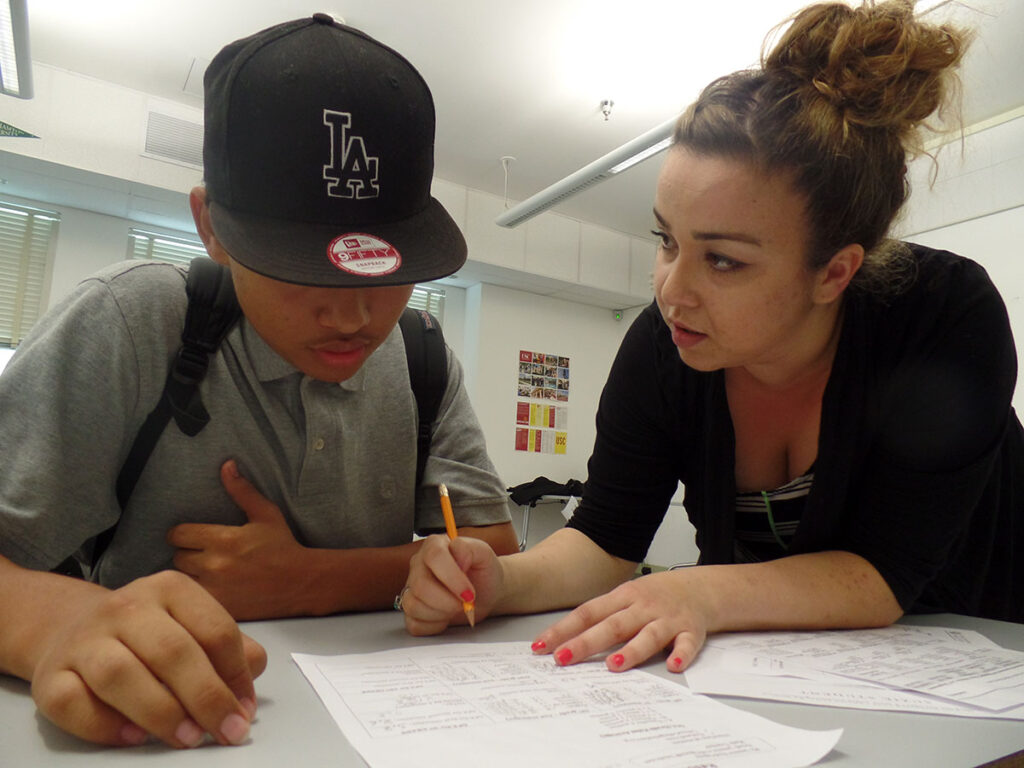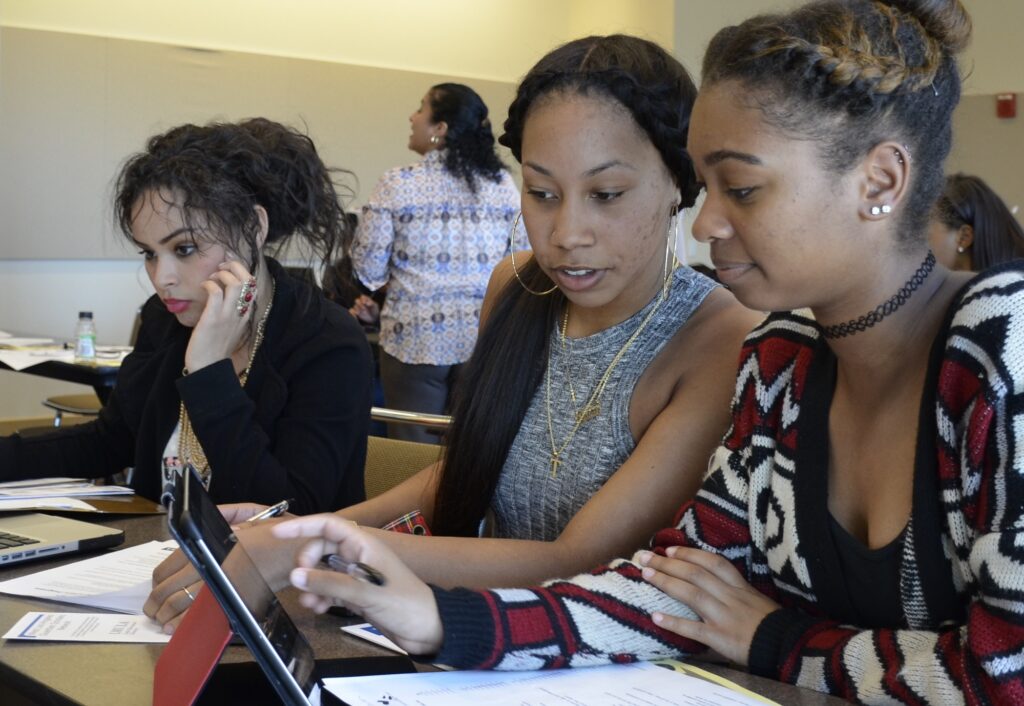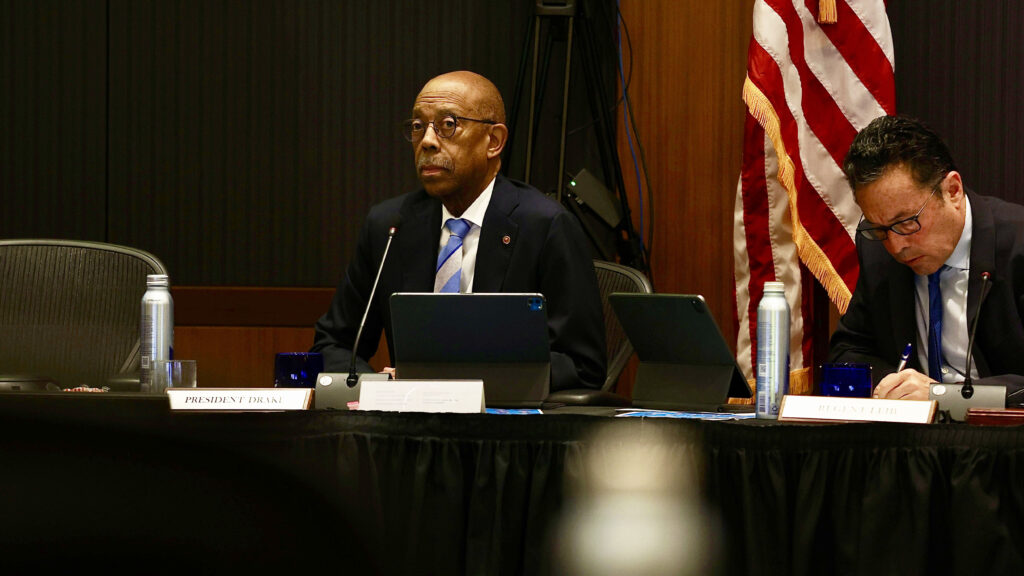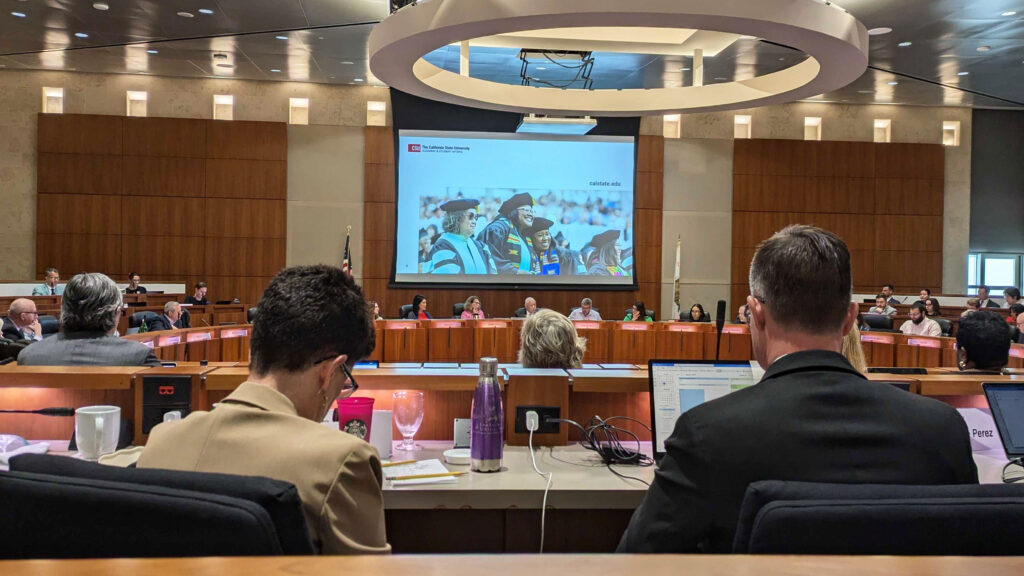
California State University officials meet for the July 2024 meeting of the board of trustees.
Credit: Ashley Bolter / EdSource
California State University is taking the forecast of a snowballing budget gap so seriously, even a recent message touting a new hire came with the equivalent of a financial weather advisory.
The nation’s largest university system welcomed Emily F. Cutrer as the new interim president of Sonoma State University last week with the stern reminder that she must address “enormous financial pressures” facing the university, where fall 2023 enrollment was down more than 36% over the last decade.
That sobering message was repeated to the system’s 23 campuses at the last board of trustees meeting before the fall term — a moment of truth when campus leaders aiming to reverse declines in student enrollment will find out if their bids to attract and retain students worked. Even if efforts to boost enrollment succeed, cutting costs could prove a necessity on many campuses, CSU officials warned. Board Chair Jack B. Clarke Jr., addressing school presidents directly, said they ultimately will determine how to manage limited resources.
“Presidents, we understand that you’re going to have to make some hard decisions and, within your campus communities and your general communities, you’re going to be criticized,” he said. “Understand that we’re behind you in terms of making the hard decisions.”
CSU could be staring down a $1 billion budget gap in the 2025-26 school year as the result of dwindling state support for higher education and rising costs, staff said at the July board of trustees meeting.
CSU has also unveiled a plan to reshuffle dollars from campuses that fall short of enrollment goals. In April, the system released a preliminary budget document sketching how the system could reallocate $32 million in enrollment funding from 12 campuses that didn’t meet resident enrollment targets or target increases and shift it into nine campuses where 2024-25 resident enrollment targets have been increased. A CSU spokesperson said the system is finalizing those plans over the coming weeks.
The system expects more budgetary trade-offs going forward, CSU Chief Financial Officer Steve Relyea said to trustees at their July meeting. Major expenses include a backlog of facilities and infrastructure projects, employee compensation costs and obligations the schools must meet under legal mandates such as Title IX, the federal law barring sex-based discrimination in schools.
“We anticipate negative impacts on academic offerings and student support services,” Relyea said. “The funding that we’re receiving, while it’s more, is still not sufficient to cover the increased cost on our current operations, and at this point universities will likely have to redirect significant dollars from existing university budgets to cover employee compensation commitments.”
Enrollment drops lead to cuts
CSU earlier this year agreed to a 10% raise for faculty represented by the California Faculty Association following a one-day strike. Trustees last week voted to approve salary increases for four campus leaders over the objections of some speakers during public comment.
The grim forecast underscores the challenges facing CSU at a time of flagging student enrollment across higher education amid declining public trust in the value of a college degree. Systemwide, fall 2023 enrollment stood more than 30,000 students shy of its 2020 peak.
Campus efforts to entice students back to campus include easing transfers into the system, reengaging students who started but did not finish a degree and more support for students of color. And CSU leaders say they remain focused on long-term goals like boosting graduation rates for historically underrepresented students and rebuilding trust in Title IX and other anti-discrimination programs.
Funding those priorities will require hard choices. Officials anticipate they can partially plug holes in the budget with reserve funds, but they said school presidents and the system itself must tighten their belts to cover the rest — cuts they acknowledged could prove painful and unpopular. The university system also will have to contend with pressure from faculty, who argue they should have a greater say in university decision-making.
Cuts are nothing new at some CSU campuses. In recent years, as enrollment fell more than 15% from pre-pandemic levels at schools including Cal State Channel Islands, San Francisco State and Sonoma State, campus leaders have held off on filling some open positions or launched voluntary separation programs to reduce staffing costs. Cal State Monterey Bay in May announced 16 layoffs and an additional 86 departures under an early retirement program. At Cal State East Bay, another campus that has seen a dip in enrollment, campus leaders in May announced that the school would no longer sponsor its women’s water polo to save money.
“Upending 19 student-athletes’ East Bay careers is without precedent,” said Jeff Newcomb, a lecturer and president of the California Faculty Association’s East Bay executive board, at the July meeting. “Going forward, authentic shared governance — it’s hard— but it’s crucial if we are to emerge from austerity measures with trust and strategic vitality.”
Take Sonoma State as another example.
The school has weathered enrollment declines with serious cost-cutting. To manage a budget shortfall, spokesperson Jeffery Keating said in a statement, Sonoma State has trimmed $21.4 million from its base budget since 2020-21 and plans an additional $7.5 million cut in 2024-25.
Some of those savings have come from reducing the number of faculty and staff, including through attrition and early retirement programs. Keating said faculty and staff headcount fell 22% between 2019 and 2023.
The aim has been “to protect student services and academic programs,” according to the statement, and the school doesn’t plan to scale back areas like financial aid, health services or career counseling.
He said the school sees some positive signs on the horizon: It projects that net student headcount will rise in 2024-25.
Across the system, CSU anticipates a $218 million shortfall this school year, according to a budget presentation. Making up the difference in funds likely will require tapping into reserves and “aggressively pursuing new students and working to retain current students,” said Ryan Storm, the system’s assistant vice chancellor for budget.
The budget presentation was not the first time Cal State has flashed financial warning signs.
The cost of educating CSU students far outstrips the money the system actually has to educate them, a 2023 report by CSU leaders found. Trustee Diego Arambula reminded colleagues last week that the gap between what the system estimated it should spend to meet student needs and what it does spend was $1.5 billion, and could grow as campuses trim their budgets.
The search for savings
The search for cost savings starts with the central office, Chancellor Mildred García said.
The Chancellor’s Office is reviewing each of its divisions in pursuit of “not efficiency for its own sake or purely for cost savings, but for mission-driven efficiency,” she said in a report to the trustees. In that vein, the office will split the division of academic and student affairs into two, a reorganization García said was estimated to save at least $500,000.
The July meeting also highlighted CSU’s smallest university — Cal Maritime — as both a cautionary tale and a possible inspiration for how the system’s campuses might share costs and academic programs in the future.
The board considered a proposal to merge the maritime academy into Cal Poly San Luis Obispo in a bid to save the Vallejo-based maritime school following a steep drop in enrollment and rising overhead costs. The board will resume those discussions in September and make a final decision in November.
Cal Maritime interim President Michael J. Dumont told the board the school has “taken a chainsaw to every expense on our campus” in pursuit of financial sustainability. Trustees praised the proposal to integrate the maritime academy into Cal Poly San Luis Obispo as an “elegant solution” that would save costs as the campuses consolidate administrative services and other operations.
CSU officials have left the door open for future campus mergers but say no additional integrations are immediately planned.
A document announcing the integration proposal said it’s in keeping with CSU’s goal to look for cost savings “from consolidation of certain administrative functions and from inter-campus cooperation and collaboration in the offering of programs and services.”
In response to questions about whether future campus mergers are likely, a CSU spokesperson cited a document that says CSU “must remain open to considering all options in the future to ensure the financial health of the system and its universities.”
That includes ongoing initiatives to save money short of full mergers, such as negotiating systemwide contracts with vendors and purchasing electricity for multiple campuses on the wholesale energy market.
“There are a lot of tools in the toolkit in addition to an integration like this,” CFO Relyea told trustees last week.
And Relyea noted that the $1 billion budget gap forecast for the 2025-26 school year is an estimate based on assumptions that could prove flawed. A shortfall could be avoided by making permanent cuts this school year, pausing new investments, bridging the gap with reserves and successfully lobbying the state for additional money, he added.
Some campuses might try to streamline their budgets in ways students won’t notice.
That’s the goal at Cal State Northridge, where administrators said that measures like cutting nonessential staff travel or delaying plans to replace older technology and equipment were among the ways they hope to save money.
“Everything that’s related to student success, we’re trying to shield that as much as we can,” said Edith Winterhalter, who leads the university’s budget department. “It’s really on the administrative side that we’re doing a lot of strategies to reduce our costs as much as we can.”
‘A painful year’
A wild card in CSU’s finances is its reliance on the California Legislature, which has funded roughly 60% of the school system’s operating costs in recent years. That can expose the university system to swings in state revenue.
CSU dodged the worst in this year’s budget. Early budget drafts proposed pushing a 5% funding hike that had been promised for 2024-25 into the following year. The final budget landed on a compromise: a one-time cut of $75 million, offset by an ongoing increase of $240 million. Staff attributed the improvement to an energetic lobbying campaign on behalf of the universities.
The budget outlook going forward is less rosy. Anticipating more lean years ahead, state legislators envision an 8% cut to CSU’s ongoing state funding in 2025-26, according to a CSU budget presentation. On top of that, state legislators have proposed that CSU front $252 million in the 2025-26 school year, which the state would subsequently reimburse in 2026-27. A similar spend-and-reimburse maneuver would occur in the 2026-27 school year.
Such an arrangement could prove risky for Cal State, Storm observed.
“If we spend, in advance, hundreds of millions of dollars and the state does not reimburse us, it would significantly deplete our one-time balances and reserves, and we could be left with new ongoing commitments and no new funding to support them,” he said.
That reality has compelled Cal State to look to grow other funding sources, including what students pay to attend its universities. Trustee Christopher Steinhauser defended the board’s previous decision to increase tuition by 6% annually starting this fall, saying the additional revenue will allow the system to save hundreds of jobs.
“We heard earlier in the spring we have to do less with less,” Steinhauser said. “This is going to be a painful year. … If we didn’t pass that tuition, we would be in a whole big mess, much bigger than we’re in now.”
CSU leaders have also pointed to other possible sources of funding, including operating campuses year round and pursuing more public-private partnerships. Trustee Larry L. Adamson urged university presidents to think creatively about raising money from philanthropic sources as one additional revenue stream.
“How many endowed chairs do we do every year in the CSU? And I think the answer is few to none,” he said during last week’s meeting. “We have to start doing more and more of that kind of thinking, as the UCs and privates do constantly. And instead of trying to just raise money for buildings, which we do a lot of, let’s start trying to raise money that offsets our actual ongoing expenses.”






















